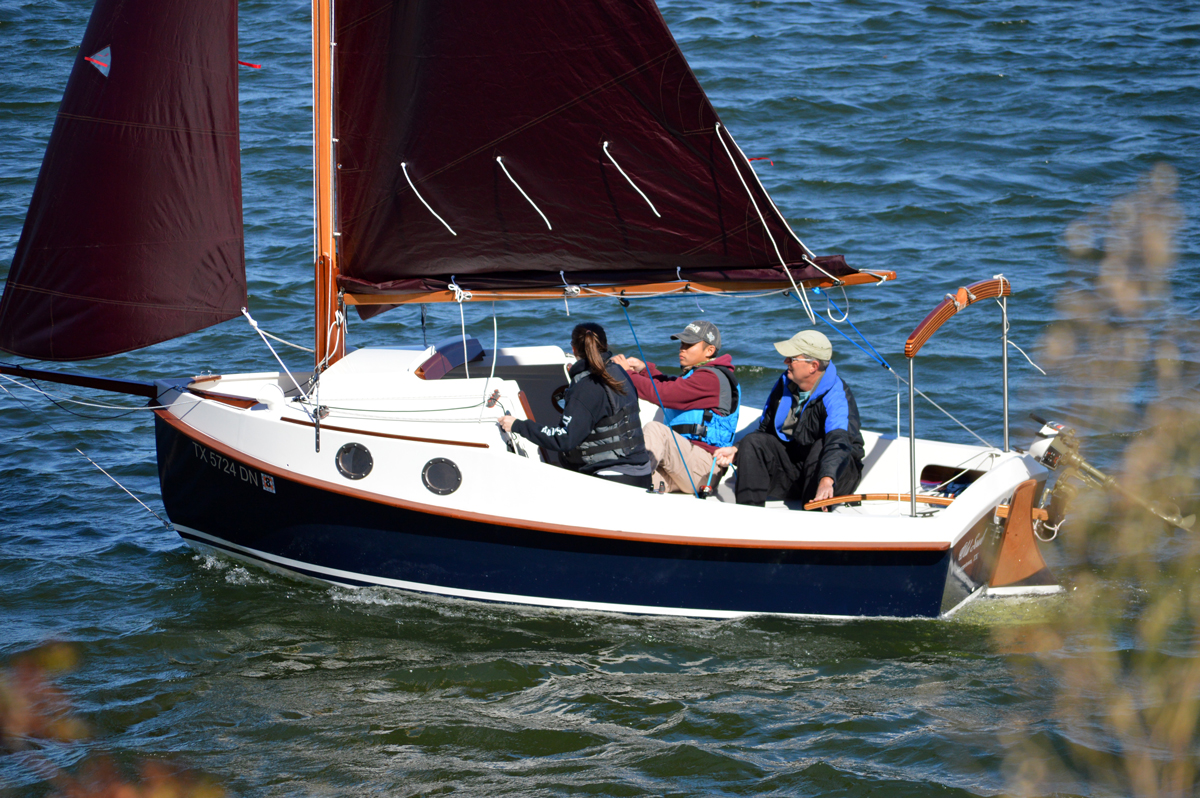Things are starting to come together more now and I think you'll be able to get a much better idea of how the boat will look. The floorboards are permanently in place (I hope).
 |
| Floorboards |
I have made several changes to the cuddy floor and to bulkhead 8 (BH8), just aft of the floor, as discussed in previous posts.
 |
| Aft end of Cuddy Floor |
On each side I have installed plastic conduit leading from the front storage/battery compartment to the two aft-most corners of the boat. Heavy (6AWG) DC wiring and things like VHF antenna coax will be run through the conduits. The holes in BH8 for the conduit (not part of the original plans) have been sealed with marine-grade sealant foam. Looks messy, but will do the job (those of you who have used "Great Stuff" know how hard it is to be neat with this kind of foam). The foam seals can be cleaned up with a knife and sandpaper, but they are in an awkward position and I don't want to take a chance on cutting into the epoxy. After the cockpit is in place, they can only be seen by crawling back into a very small space. I hate to leave them like this, but it is better than taking a chance on compromising the epoxy seal.
 |
| Inside Transom Compartment |
Inside the transom compartment you can see the conduits and their seals. I have painted the bilge area with more of the epoxy-based bilge paint. The instructions call for the entire compartment interior to be painted, but for the life of me I can't think of a good reason to do that, so for now at least I'm going to leave it as is. Everything is covered with several coats of epoxy. The epoxy can be damaged by sunlight, will be protected from the sun. Sunlight can reach small areas of the compartment floor when the "lazarette" hatches are open, so I may decide to paint those areas.
Two small (14 AWG) wires have been run alongside the conduits from front to back in case I later find a need for electricity in the rear of the cuddy. The new standard for DC wiring is red for positive and yellow for negative. This is to avoid confusion with AC code, where black is the "hot" wire. You can also see strings I ran alongside the conduits. These will enable me to easily pull more wire if I ever need to.
In the bottom-center of BH8 I have installed a small drain plug. The transom compartment is supposed to stay relatively water-tight and help keep the boat afloat if it is ever flooded. (There will also be a lot of floatation foam in that compartment and several other areas of the boat.) There will be two "lazarette" hatches to allow access to storage inside the transom compartment. These hatches have been known to leak, so any water that gets in must be removed. My modification was to install the drain plug so I can drain water from the transom compartment into the cuddy bilges where it will be much easier to pump out. I just have to always remember to replace the plug before sailing. There is another plug that goes in the forward-most bulkhead for the same purpose. The hull hardware kit included two of these plugs and I read somewhere that the BH8 plug was part of the original design, but later discarded.
Cockpit Footwell Dry Fit
This seems like a good time to show you how the cockpit and its footwell will affect the cuddy space. The dry-fitting of the footwell comes a little later in the instructions, but I'm doing it now for illustration.
 |
| Footwell Dry Fit |
As you can see in the above photo, the footwell intrudes into the cuddy space. The cockpit seat will intrude all the way to the front end of the centerboard trunk, some of which appears in the photo. So from the CB trunk back, the cuddy roof is only about 1'4" high. (Under the footwell it is only a little over 6" high.) But the cuddy floor is 4'3" long from the front storage compartment to the CB trunk, and in that area the roof is over three feet high. The idea is that the forward area of the cuddy is for sitting around in, and the rear area is for stretching your legs out when sleeping. Two basketball players could fit in there comfortably (as long as they are careful not to bark their shins on bulkhead 7 while stretching out). The cuddy is obviously pretty tight, but it is the roomiest I was able to find in any boat this size.
 |
| Footwell and Transom Compartment |
This shot shows the footwell and transom compartment. The two conduits have not been cut to length as yet, but they will come through holes I will cut in the cockpit seats near the aft corners. (Those holes will also have to be sealed as in BH8.) It is possible that water will eventually find its way inside the conduits, even though I plan to bend them downwards at the ends. So I will need to find some way to temporarily plug them. My Lake Michigan sailing friend, Orval Quamme, suggested plumber's putty, which I think is a great idea. It will form a good seal, but can be easily removed when necessary. (Orv is actually Jan's friend from High School in Madison, WI, but I have met him and we correspond quite a bit about boating.)










